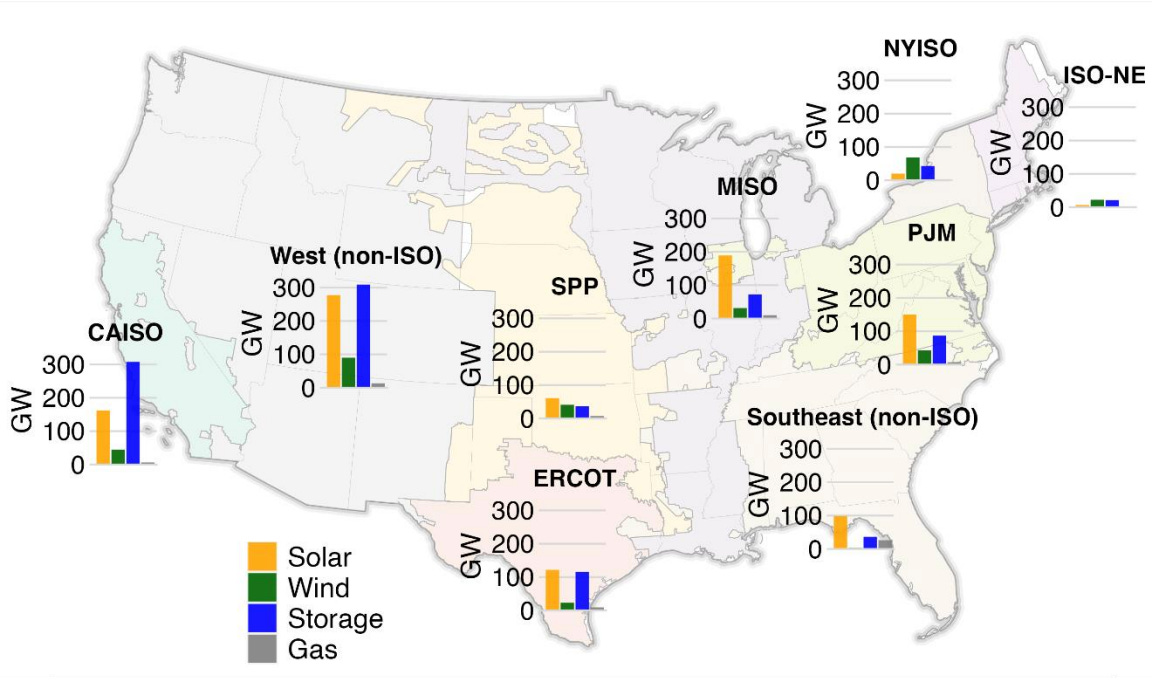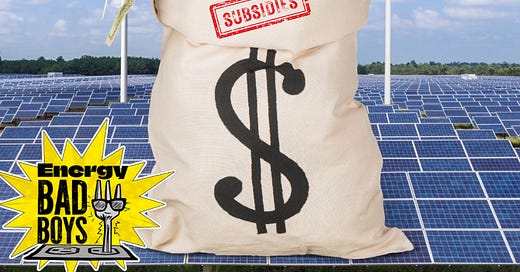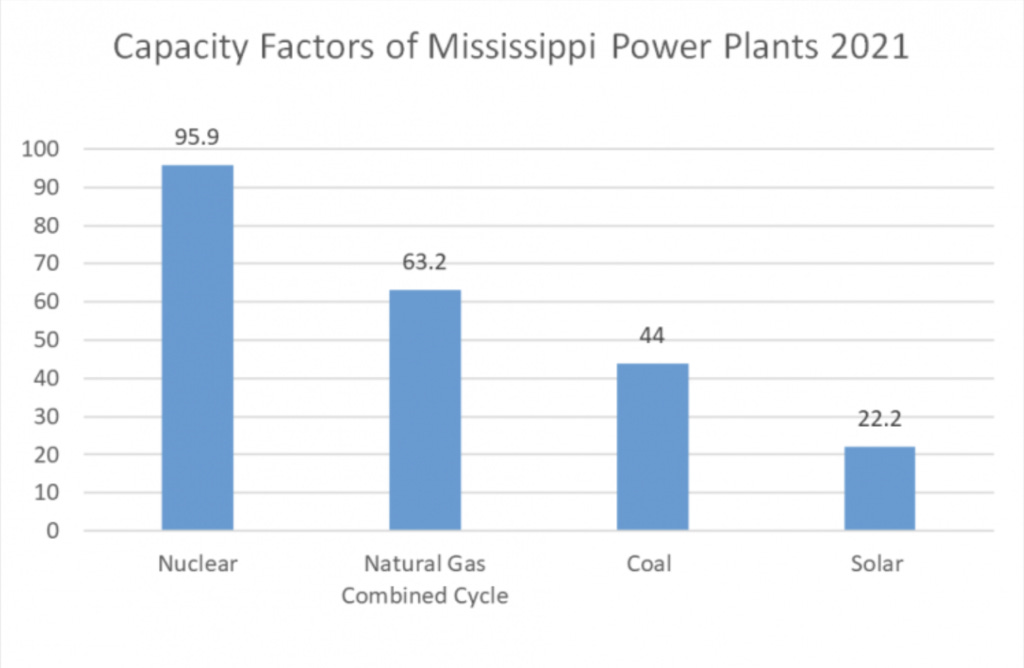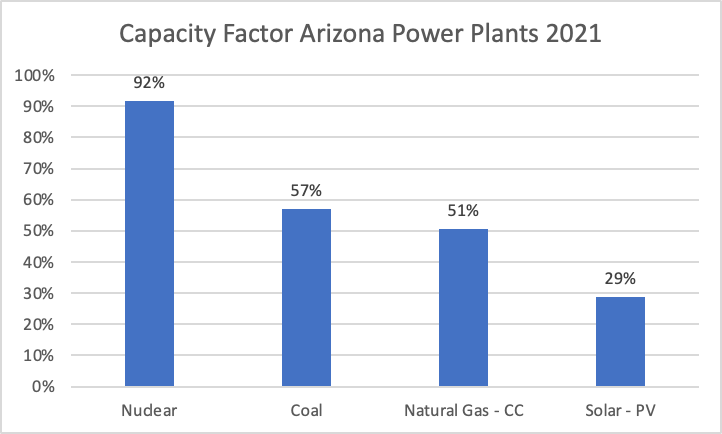Solar Subsidies Will Incentivize Irrational Energy Decisions
The biggest problem with subsidies is that they incentivize rational actors to do irrational things.
The biggest problem with subsidies is that they incentivize rational actors to do irrational things.
In August 2022, President Biden signed the so-called “Inflation Reduction Act,” a billion spending package that could cost up to $3 trillion.
Sadly, the IRA will do little to reduce inflation. It will, however, do a lot to subsidize solar power production and lead to market distortions that will increase the cost of electricity for families and businesses across the country. While IRA subsidies will also incentivize more wind energy, today we’re focusing on solar because it represents the most capacity currently in interconnection queues in the United States, as shown in the map below.

Why subsidizing solar is irrational
The IRA provides a 30 percent Investment Tax Credit (ITC)—although some grid planners are now modeling the PTC for solar due to the growing pervasiveness of negative wholesale power prices— for solar that will incentivize electric companies to build facilities that otherwise would not make sense from a business standpoint.
To understand why it is irrational to subsidize solar, it helps to understand some basic facts about how this technology works.
A solar power facility, often called a solar “farm” because of the large amount of land required for utility-scale electricity production, is referred to by its maximum capacity — 100 megawatts, for example. This is known as their “nameplate” capacity. But the reality is that power plants rarely operate anywhere near their capacity, and solar plants are among the worst in that regard.
Statistics from the United States Energy Information Administration (EIA) show solar farms in Mississippi, for example, only utilized about 22 percent of their total capacity in 2021. That means a 100-megawatt plant is operating, on average, like a 22-megawatt plant, although customers are paying for a 100-megawatt plant.
This productivity percentage is commonly referred to as a “capacity factor.”
The capacity factor of solar facilities in Mississippi compares poorly to other energy sources like nuclear, which produced 96 percent of its potential output in 2021 (though it averaged only 62 percent over the previous five years). Additionally, natural gas combined cycle plants, the most efficient natural gas plants, produced at 63 percent capacity factors, while coal plants produced at 44 percent, as shown in the graph below.
This is true not only for Mississippi but also for areas with the best solar resources, like Arizona.
We can’t control the weather
Even these data points may overstate the usefulness of solar power because the panels can only produce electricity if the sun is shining, which is obviously beyond our ability as humans to control. On the other hand, the capacity factors of natural gas and coal plants could be improved by simply burning more fuel.
This point is crucial because one of the most important things to know about the electric grid is that electricity is generated to meet demand when that demand occurs. Think about what happens when you turn on a lamp or the air conditioner — you expect, or “demand” electricity to be there.
If demand rises in Mississippi, for example, as households turn on their air conditioners or heaters, electric companies must increase the supply of electricity on the grid to meet it.
Generating more electricity on demand is relatively easy with natural gas power plants, and it’s nearly impossible with solar power when the sun doesn’t happen to be shining. When the sun is down and solar farms are producing no electricity, grid operators need to call on other resources to meet the electricity needs of households and businesses.
If the grid becomes too reliant on intermittent and weather-based resources like solar, households and businesses would be at the whim of favorable weather conditions to use electricity when needed. This is already occurring in places like Texas and California, where the electricity grid is far too reliant on wind and solar energy and grid operators deploy conservation notices regularly to help ease demand when wind and solar supply is low.
This is why healthy grids keep enough natural gas, nuclear, and coal power plants online, regardless of how many solar panels are built, to ensure the lights stay on when the sun goes down and the wind doesn’t blow.
Understanding these physical realities is essential for understanding why the Biden administration’s subsidies for solar will ultimately drive up the cost of electricity for families and businesses across the country.
Utilities will take advantage and increase rates
Some economists have suggested that utility companies are not truly private companies because they are government-approved monopolies with the exclusive right to sell electricity in their service territories. Customers living in those territories are legally obligated to purchase their power from the monopoly.
Because electric companies are monopolies, it would be unfair to allow them to charge whatever they wish. As such, the price of electricity must be approved by regulators at the state Public Service Commission (PSC) using a cost-of-service formula, also known as the revenue requirement formula. This structure allows an electric company to charge enough to recover the cost of providing power, plus a government-approved profit between 9 to 10 percent on equity on the new infrastructure it builds. This is true whether it be a natural gas plant, a solar plant, or even new corporate offices, just as long as the Public Service Commission approves it.
They even get reimbursed — and earn a profit from electricity customers — when they buy new furniture!
This regulatory structure means that every dollar spent on new infrastructure will be added to electricity rates. This unfortunate reality is compounded by the fact that solar power, which is not available 24 hours a day, cannot replace natural gas plants, meaning that customers will pay for the natural gas plants and the solar plants, not whichever one happens to be lower cost.
The subsidies enacted by the Biden administration will make solar power appear more affordable on paper (never mind that subsidies don’t change the cost of a product or service, merely who pays for it) and this will entice electric companies to build more solar facilities to bolster their bottom lines for their shareholders, even though it would make more sense for ratepayers to utilize existing natural gas, coal, and nuclear facilities.
In this way, the IRA is merely subsidizing utility profits.
In this instance, it is the job of the Public Service Commissioners to scrutinize proposed projects and protect ratepayers from the rising prices that would accompany the construction of the new solar facilities. Sadly, the fact that PSC commissioners have approved $1.4 billion in renewable energy projects since 2020 — which will necessarily drive up prices — suggests that the PSC commissioners have not put the interests of ratepayers first.
While the subsidy package signed into law by President Biden was called the Inflation Reduction Act, it would be more aptly named the Inflation Production Act because the end result of the solar subsidies will be higher electricity prices for Mississippi families and businesses.
Thanks for reading Energy Bad Boys!
Please like, share, and subscribe.
We have huge news to share in the coming weeks. Stay tuned!
The EPA’s Emissions Rule Will Strangle AI In The Crib by
FERC’s Order No. 1920: A Costly Shell Game by









When governments subsidize projects, citizens pay twice—once as taxpayers who indirectly pay the subsidy, and then again as consumers in higher prices for the goods they buy and in reduced consumption.
All to buy votes from “low information voters” that don’t understand why the cheese is FREE in the mousetrap.
Welcome to 1984.
Apparently it has to be said over and over again, the average capacity factors fall short of indicating the real weakness of the intermittent providers. For solar, the capacity factor is zero overnight and during severe wind droughts that can lasts for days (and nights) the capacity is can be little more than zero.
Hence windless nights are the weakest link in the wind and solar chain and in the absence of grid scale storage that can last for several days the shooting match is all over. There will be no transition to wind and solar in our lifetime. Game, set and match.
It is five minutes to midnight for the power system, in some 19 states authorities have warned that there will be critical problems within three or four years if conventional power continues to run down under the influence of the inflation-promoting Act.